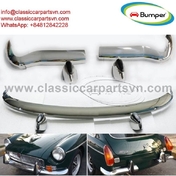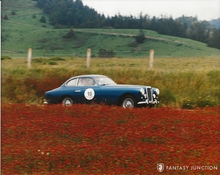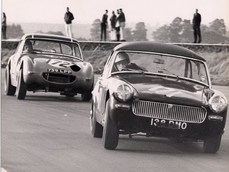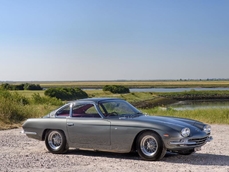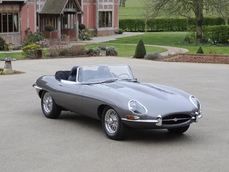MG Other Special 1952
General description :
This car is the very important and historic 1952 Tojeiro MG Special, built by John Tojeiro.
John Tojeiro set up his first workshop in 1950 behind the garage of his friend Vin Davidson and over the next two years he began to build his own sports car as a replacement for his MG. The chassis was to his own design and utilised two large tubes with fabricated triangular sections at each end as opposed to the box-sectioned chassis originally favoured by other designers of the period, such as John Cooper. However, Tojeiro did copy the Fiat 500 suspension system that Cooper had employed with transverse leaf springs and bottom wishbones while the hubs and steering rack were Morris components, albeit with necessary modification. The engine was an MG XPAG unit with quad side-draft Amal carburettors and the body was initially a single seater cigar-shaped design with open wheels and cycle wings. Tojeiro later recalled that as the project was nearing completion in mid-1952 a chance meeting with Cambridge University student Chris Threlfall meant that he ended up selling it before he even had a chance to use the car himself.
As entries in the original log book record, Threlfall registered the car on July 31st 1952 under the number MVE304 while he was still at Caius College Cambridge. Threlfall wasted no time in putting the Tojeiro to good use and entered two meetings at Silverstone in September, winning on both occasions, and another at Castle Combe in October. After a break over the winter he began the 1953 season with an entry to the Goodwood 11th Members Meeting held on March 21st and followed this up with another appearance at Castle Combe on April 4th where he came 3rd. He managed to break the class record at Bo’ness in June but the most important event for Threlfall that year was the British Empire Trophy race held on the Isle of Man in June where he qualified 9th but unfortunately did not finish.
Following Threlfall’s period of ownership the next custodian of KVE304 was James Fiander of Blandford, Dorset who acquired the car in March of 1954. Fiander’s first race was at Goodwood on March 27th where he managed 6th in one of the handicap races. He followed this up with a 3rd at Castle Combe on April 3rd and bettered this with a 2nd at Goodwood in May. Over the next two months he amassed three more 3rd places and a 2nd at club events at Ibsley and Silverstone. The main event for Fiander so far was the 1.5 Litre British Grand Prix held at Silverstone on July 17th where he came home a very creditable 12th. He followed this up with a 3rd and a 5th at Brands hatch on August 2nd and a 3rd at Goodwood almost three weeks later. The last two races of the season for Fiander were at Castle Combe in August and Crystal Palace in September where he placed 3rd and 4th respectively. After a successful 1954 season Fiander seems to have been relatively quiet in 1955 and it may be that it was during this hiatus that the car received the revised body it wears today. The next recorded outings for KVE304 are not until 1956 when it was in the possession of Peter Stuart Bailey who raced it three time in May and June at Brands Hatch and Mallory Park where he secured a win on May 21st. It seems Bailey only kept the car for a few months before selling it to a Neville William Gough who entered the car into another race at Mallory in September of 1956 where it was driven to 3rd place. The car remained with Gough until 1961 when it purchased by Henry Scrope of county Durham and it was Scrope who eventually exported the car to the US in late December 1963. Following its arrival in California in early 1964 the car was campaigned in a number of West Coast events before being partially stripped in anticipation of a rebuild that never materialised. Instead the car remained in storage for several decades before being repatriated and acquired by ourselves in 2017.
In view of its extended period off road, the car is currently in a very original yet dismantled state but is mostly complete, although the rear bodywork is missing. All major mechanical components are present including the engine with Laystall head, Amal carburettors, close ratio gearbox, ENV back axle, Electron disc wheels, correct suspension, instruments and steering components. It is accompanied by a fascinating history file including many period photographs and documents and offers a very exciting opportunity to acquire one of John Tojeiro’s first sports car's with a fabulous competition history that would make it eligible for all prestigious historic events. The car can be purchased as is or completed by Woodham Mortimer to customer specifications.
Please contact us for further details.
1952 MG Other Special is listed for sale on ClassicDigest in Essex by JD Classics for £45000.
Car Facts
Car type : Car Make : MG Model : Other Model Version : Special Engine size : 1.3 Model Year : 1952 Location : Maldon Vehicle Registration : Undefined
45000 £
People who viewed this MG Other also viewed similar MG listed at ClassicDigest
Other cars listed for sale by this dealer
About MG
The MG (Morris Garages) story is a rich tapestry that spans several decades and involves various owners and corporate entities. Here is an overview of the MG story from its inception to the challenging period under the British Leyland (BL) corporation, highlighting key models and their specifications:1. Foundation and Early Years:
Year of Establishment: 1924
Founder: Cecil Kimber
Initial Focus: Coachbuilding and customization of Morris cars.
2. MG Octagon Logo:
The iconic MG octagon logo was introduced, representing the merger of MG with Morris.
3. MG M-Type Midget (1929–1932):
Key Features:
Compact two-seater.
Powered by a 0.8L engine.
The beginning of the Midget series.
4. MG T-Series (1936–1955):
Key Models:
MG TA, TB, TC, TD, TF
Key Features:
Roadsters with classic styling.
Success in motorsports, particularly in pre and post-World War II eras.
5. Post-War Era and MG A (1955–1962):
Key Features:
Departure from traditional styling.
First MG to feature a streamlined, modern design.
Available as a roadster or coupe.
Powered by a 1.5L engine.
6. MG B (1962–1980):
Key Features:
Classic British sports car design.
Available as a roadster or GT coupe.
Produced in high numbers.
Variants included the powerful MGC.
7. MG Midget (1961–1979):
Key Features:
Compact sports car based on the Austin-Healey Sprite.
Affordable and popular.
Various iterations with engine upgrades.
8. MG C (1967–1969):
Key Features:
A more powerful version of the MGB, featuring a 2.9L inline-six engine.
Limited production.
9. BL Corporation Era (1968–1980):
Acquisition by British Leyland (BL):
MG became part of the larger British Leyland corporation.
Struggles with quality control and labor disputes.
Decline in product quality and reputation.
10. MG MGB GT V8 (1973–1976):
Key Features:
Introduction of a factory-produced MGB with a V8 engine.
Attempt to inject performance into the lineup during challenging times.
11. MG RV8 (1992–1995):
Key Features:
Limited production convertible.
Revival attempt by Rover Group (successor to BL) to rekindle the classic MG spirit.
The MG story during the British Leyland era marked a challenging period with a decline in quality and reputation. However, the brand continued to be associated with classic British sports cars.















